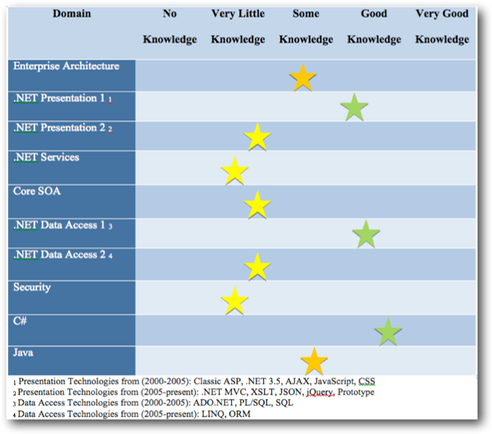Web-based Tutorial Curriculum Design
The following curriculum design class that followed the ADDIE model was completed as part of the AET/545 E-Learning Technologies Design class. The supporting papers and class assignments for AET/545 can be found here. The completed implementation of the online Web Applications Design class (lectures and hands-on programming labs) that I designed can be found here.
Analysis
I inherited a new software development team and determined there was a need to complete a technical skills assessment on the members of the team. The skills assessment served a number of objectives. The objectives of the skills assessment were to determine the current technical skills on the software development team, to determine what technical skills needed to be added to the team by hiring new software developers, and to determine what technical skills needed to be added to the team by establishing a training plan for each of the team members. After completing the survey with the software development team the survey data was compiled and analyzed. The following summarizes the results of the survey. Also determined from the survey was that there was an overwhelming desire by the team to learn and work on newer technologies. The complete Web-based Tutorial analysis can be downloaded here.

Design and Development
From the survey data and analysis obtained in the needs assessment it was determined that a software development team lacked experience and training in a number of key technical areas related to web application design using the Microsoft .NET platform. A Web Application Design training class with hands-on programming labs was required for the software development team. After completing the Web Application Design lectures the students will be able to properly model and design a N-Layer (including a Presentation Layer, Business Services Layer, and Data Access Layer) web application leveraging the Microsoft .NET platform. The students will be introduced to industry best practices, technology frameworks, and learn an Event-Driven design methodology for the Presentation Layer. Web-based hands-on programming labs will be added to the existing Web Application Design class lectures to augment and improve the class. The complete Web-based Tutorial Goals and Learning Objectives are listed below and can be downloaded here. The complete Web-based Tutorial design can be downloaded here.
Goals
- 1.Provide the students with a series of hands-on programming labs that can be used to augment the Web Application Design classroom lectures so they can apply the learning objectives from the lectures using practical hands-on programming experience.
- 2.Provide the students an opportunity to build a N-Layer web application using the business requirements and the Unified Modeling Language (UML) models developed from the lectures in the Web Application Design class.
- 3.Incorporate the Event-Driven Design methodology learned from the lectures during the development of the web application built in the hands-on programming labs.
- 4.Incorporate the Design by Contract methodology learned from the lectures during the development of the web application built in the hands-on programming labs.
- 5.Implement the business process from the Unified Modeling Language (UML) models developed from the lectures during the development of the web application built in the hands-on programming labs.
- 6.Implement and apply common industry design patterns, such as the Model View Controller and Data Access Object design patterns, during the development of the web application built in the hands-on programming labs.
Objectives
- 1.After completing the labs the students will be able to demonstrate the ability to create a default .NET MVC project.
- 2.After completing the labs the students will be able to apply an Event-Driven design methodology to implement the .NET MVC Controller used to design the Presentation Layer of a web application.
- 3.After completing the labs the students will be able to demonstrate how to develop an enterprise canonical object model and enterprise canonical services model used to support the Business Services Layer of a web application.
- 4.After completing the labs the students will be able to demonstrate how to develop the data persistence services using the Data Access Object design pattern used to implement the Data Access Layer of a web application.
- 5.After completing the labs the students will demonstrate a fully functioning N-Layer web application.
- 6.After completing the labs the students will be able to identify at least 10 industry best practices that have been incorporated into the functional N-Layer web application.
- 7.After completing the labs the students will be able to develop maintainable code and demonstrate this objective by performing a peer code review on another student’s application code.
Implementation
The completed implementation of the online Web Applications Design class (lectures and hands-on programming labs) that I designed can be found here.
Evaluation
The Web Applications Design lectures and online lab classes have been presented numerous times to a software development team. During each iteration I have gone back to update the design and implementation accordingly based on feedback I have received from students during and after the classes.